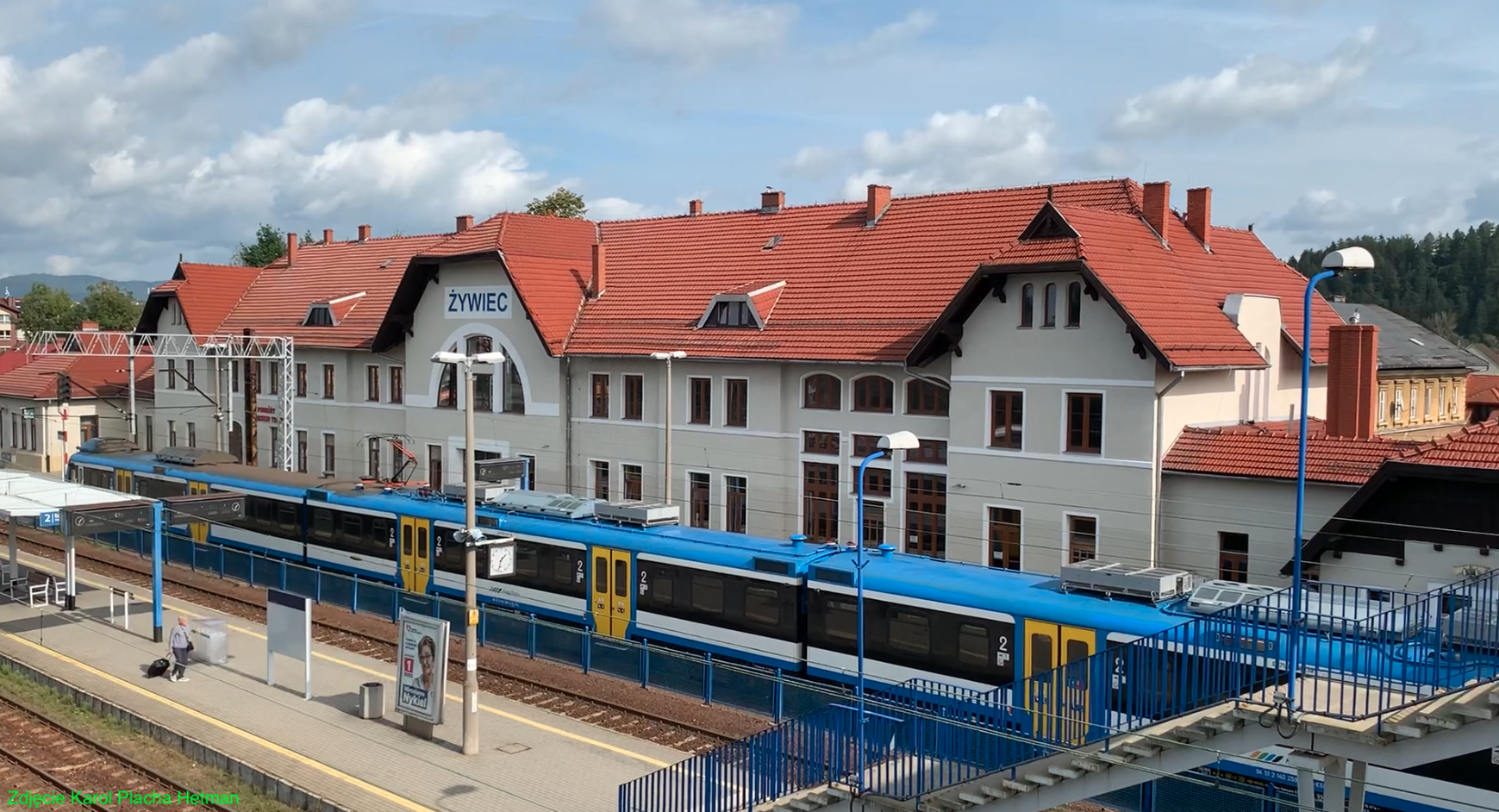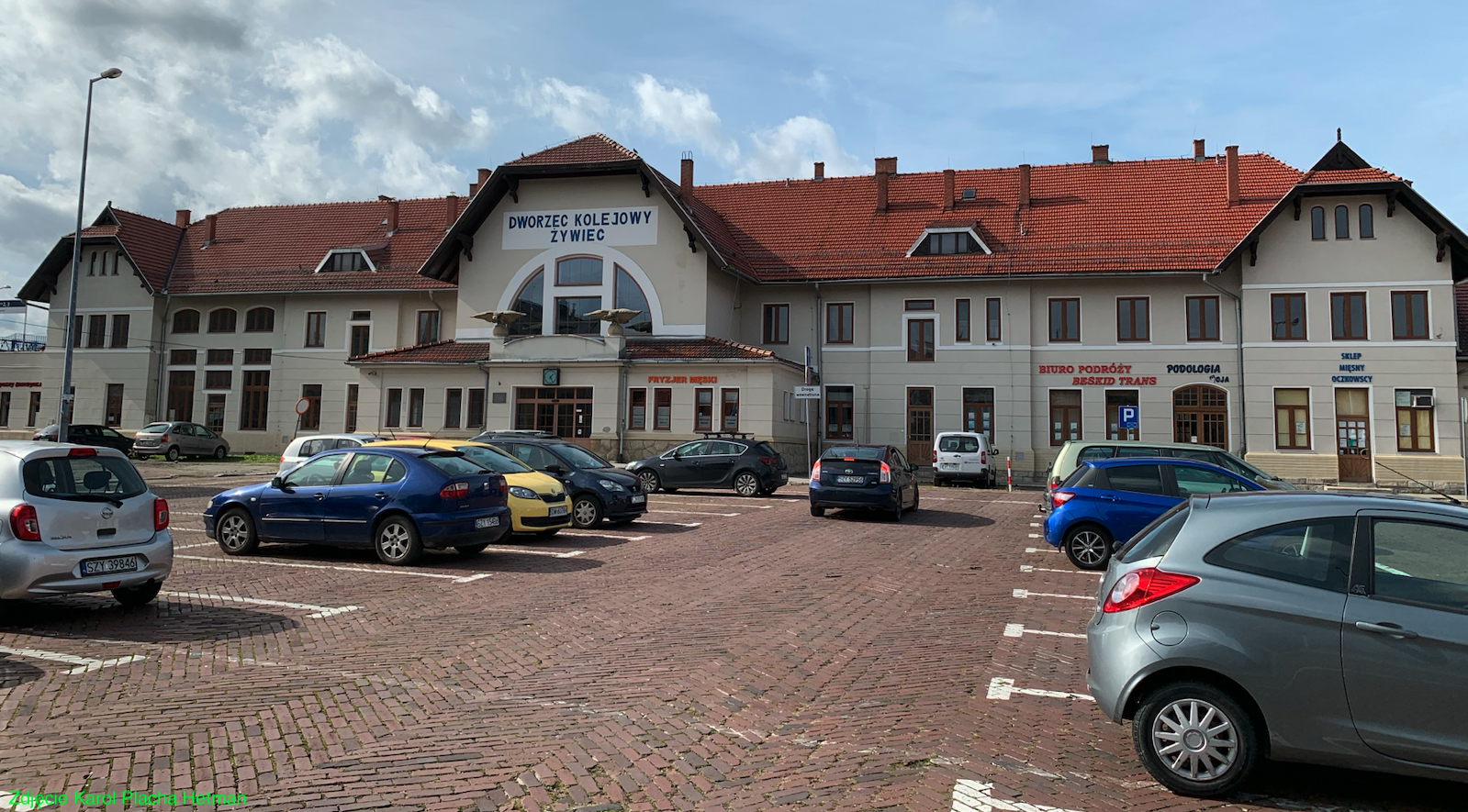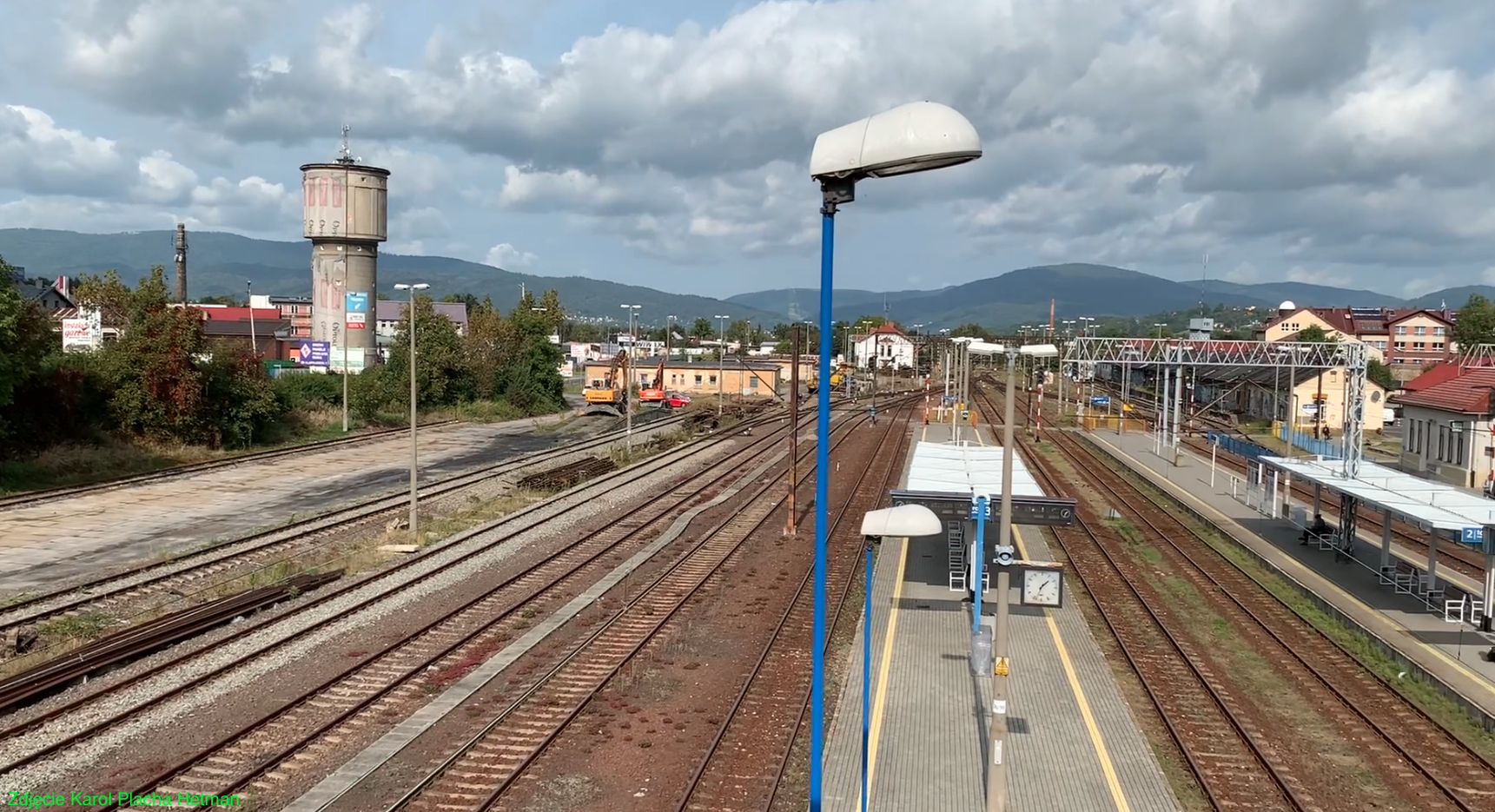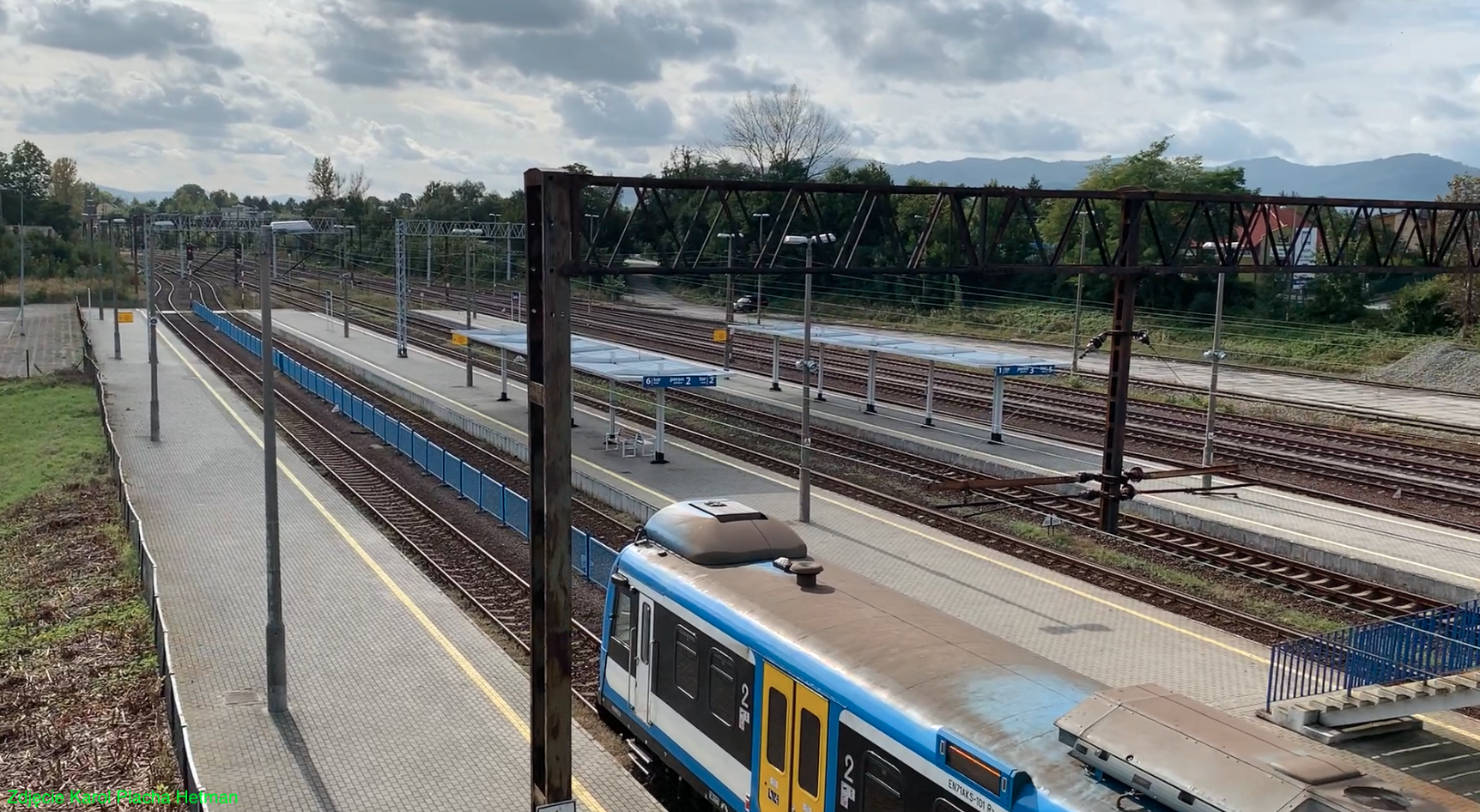Żywiec 2023-10-12
Żywiec railway station.
Geographic coordinates: 49.679N 19.185E. Elevation 353 m.





The city of Żywiec.
Żywiec is a city located in southern Poland, belonging to the Bielsko agglomeration. Żywiec is a district town. Administratively, Żywiec is located in the Silesian Voivodeship. The city has an area of 50.54 square kilometers. The city is located in mountainous areas with an elevation ranging from 344 m to 400 m. The city's population is 30,313 inhabitants in 2021 and 29,878 inhabitants in 2022. Geographically, Żywiec is located in the Żywiec Valley, in a depression between the Beskid Mały in the north, the Beskid Żywiecki in the south-east and the Beskid Śląski in the west. The city is located directly on Lake Żywieckie (retention reservoir), which is in the course of the Sołan and Koszarawa rivers.
Żywiec is historically located in Lesser Poland, in the former Kraków Land. Żywiec belonged to the Oświęcim Castellany, then the Duchy of Cieszyn, and then to the Duchy of Oświęcim. But for over 440 years it was called the "Żywiec State". In the period 1945–1975, the city administratively belonged to the Krakow Voivodeship, and in the period 1975–1998 to the Bielsko Voivodeship. Currently, Żywiec belongs to the Silesian Voivodeship.
The first mention of the town of Żywiec appeared in 1326. The name probably comes from the noun "żywiec", an old Polish term for livestock, as illustrated by the aurochs head in the city's coat of arms. Żywiec was famous for breeding cattle, sheep and pigs. Already at the beginning of the 14th century, a Catholic parish was founded here and the first wooden church was built. Żywiec was first mentioned in a Latin fief document issued on February 24, 1327. Because the city was often hit by floods, in 1448 it was decided to relocate the city. This time at the mouth of the Koszarawa River into the Soła River. This is now the historic center of the city. From 1457, Żywiec was the property of the Polish King, Casimir IV Jagiellon. Already in 1518, Żywiec had the right to organize two fairs a year; for Epiphany and Saint Lawrence. The hospital has been operating since 1542. From 1537, Żywiec had the right to brew beer, produce vodka and sell these drinks. In 1541, the city baths were opened. In 1558, the first public school was opened. In 1579, Żywiec obtained the right to store and hold subsequent fairs.
After the partitions of the Republic of Poland, the town found itself in the Austrian partition and lay within the borders of Austria, being part of the Kingdom of Galicia and Lodomeria. In the period 1838-1944, Żywiec was under Habsburg rule and part of Galicia. The 19th century was the period of industrialization of Żywiec and the surrounding area. More breweries, metal workshops, paper mills, tanneries and charcoal production plants were established. In the 19th century, a new, representative town hall was built. More schools, health facilities, a new hospital, a printing house and a library were built. A Volunteer Fire Department was established. In the mid-19th century, Żywiec had approximately 4,000 inhabitants. There were about 400 residential houses, mostly wooden, but multi-story. There were already tenement houses in the market square. A new castle, or rather a palace, was built, leaving the old castle.
In 1878, Żywiec gained a railway connection with Bielsko - Czechowice - Mysłowice and Katowice. It was a branch of Emperor Ferdinand's Northern Railway. In 1884, the city was connected to the Transversal Railway, and through it to all important towns on the northern side of the Carpathians, through the Sucha Beskidzka station.
The Great World War bypassed Żywiec. In October 1918, Polish soldiers disarmed the Austrian unit stationed in Żywiec. In 1921, Żywiec had a population of 5,320 inhabitants. In 1925, bus communication with Bielsko and Kraków was launched in Żywiec, despite the existence of railway connections. In addition to horse-drawn carriages, the first TAXI cars appeared. The hospital was expanded. The number of medical and dental offices has increased. In 1927, a large Municipal Health Center was established with many specialist offices, which also served residents from neighboring towns. In 1932, a municipal power plant was opened, in which the generator was powered by steam machines (locomobiles).
On September 1, 1939, the Germanic army attacked the Republic of Poland. Żywiec was incorporated into the Germanic borders, into the Upper Silesian province. The last owner of the Żywiec state, Archduke Karol Olbracht of Habsburg, refused to sign the Volksliste and his property was nationalized. The Archduke was interned in Cieszyn. The Germans deported about 20,000 Poles to the general government. Germanic colonists were brought to the Żywiec region. The Żywiec region was called Heim ins Reich, meaning the House in the Reich. But many Germans came back because they did not want to live in wooden houses. The rest, after the Second World War, returned to the new, truncated Germany. Ultimately, the Żywiec state was liquidated in 1944. In March 1945, there were heavy fighting for the city. The livestock was seriously damaged. The Germans destroyed the railway bridge and two road bridges. The station was set on fire.
In September 1945, thanks to the reconstruction of the destroyed railway bridges, trains were restored on the Żywiec - Bielsko route, and in November 1945, traffic on the Żywiec - Węgierska Górka route was restored. Trains started running on the full length of the line southwards to Zwardoń in 1946, when traffic on the Żywiec - Sucha route was restored.
The communists nationalized all the property of the previous owners. In 1951, the Żywiec emergency service was established. The hospital was expanded. New primary and vocational schools were opened. In 1966, by damming the waters of the Soła River with the help of a dam in Tresna, the Żywieckie Lake retention reservoir was created. The decision to build the reservoir was made after the flood in 1958. In 1968, the Professional Fire Department was established in Żywiec. In 1971, Miejska Komunikacja Samochodowa was established. During the Polish People's Republic, housing estates with apartment blocks were built. In 1991, the names of streets that were associated with communism were changed. Usually the names returned to those before World War II.
On March 25, 1992, by virtue of the bull of Pope John Paul II, the Roman Catholic diocese of Bielsko-Żywiec was established, and the Church of the Nativity of the Blessed Virgin Mary received the rank of co-cathedral. On May 22, 1995, Pope John Paul II visited Żywiec. Currently (2023) there are five Catholic parishes in Żywiec; parish of the Nativity of the Blessed Virgin Mary, parish of Christ the King, parish of St. Floriana, parish of Divine Mercy, parish of St. Maksymilian Kolbe.
Railway station in Żywiec.
In 1878, Żywiec gained a railway connection with Bielsko - Czechowice - Mysłowice and Katowice. It was a branch of Emperor Ferdinand's Northern Railway. In 1884, the city was connected to the Transversal Railway, and through it to all important towns on the northern side of the Carpathians, through the Sucha Beskidzka station. The station was opened in 1878. Initially, the station was called Saybusch-Zablocie, then Saybusch-Żywiec, then Saybusch and finally Żywiec. Two railway lines connect at the Żywiec railway station: No. 97 Skawina - Żywiec and No. 139 Katowice - Zwardoń.
The station is located in the Zabłocie district, at 52 Dworcowa Street, 34-300 Żywiec. There is a parking lot and a TAXI rank at the station square, and public transport buses stop at the bus stop. The distance from the station to the center of Żywiec (market square) is 1,800 m and you have to cross the Soła River.
The station serves agglomeration traffic operated by PolRegio and Koleje Śląskie, as well as long-distance traffic: InterCity and TLK. In 2017, the station served up to 1,000 passengers per day. In 2018, the station served up to 1,200 passengers per day. In 2022, the station served up to 3,000 passengers per day. Currently (October 2023), 35 passenger trains departed from the Żywiec station per day. It was possible to drive to; Katowice, Zwardoń, Milówka. Koleje Śląskie operates the network and local connections; No. S5 Katowice - Zwardoń, S51 Katowice - Zakopane, S75 Rybnik - Żywiec. Due to the current development of Polish Railways, the construction of several new passenger stops is planned, including in the city; Żywiec Browar, Żywiec Łączki, Żywiec Park.
Access to the platforms is provided by a footbridge over the station platform, which was named the Home Army. The footbridge was built in the 1950s and rebuilt in 1975. The footbridge is located on the southern side of the station and connects Browarna Street (on the eastern side) with Armii Krajowej Street (on the western side). The footbridge is not accessible to passengers in wheelchairs. For these passengers, there is a passage at track level on the north side of the platforms.
Żywiec station has three platforms; Platform 1 is located at the station, it is single-edge, next to it is No. 8, length 227 m, height 0.30 m. Platform 2 is an island platform, two-edge with tracks No. 2 and 6, length 260 m, height 0.30 m. Platform 3 is an island platform, two-edge with tracks No. 1 and 5, length 255 m, height 0.30 m.
The first station building was built in 1878, and the first train was served on August 18, 1878. The station was not a typical Austro-Hungarian station, because it was single-story. What the station looked like, just look at the building north of the station, where there was a health clinic. The railway station influenced the development of Zabłocie. Warehouses, new factories, inns and inns were built here. It was planned to run a horse tram line from the station to the market square, but this was not implemented. The station became an important junction station, where a locomotive shed, a water tower, coal fences, workshops, storage yards and warehouses were built. A health clinic was built next to the station for railway workers and their families.
The railway station was rebuilt around 1895, according to the design of Robert Fussganger. A second floor and high, steep roofs were added. The station received a highlander-beskid style. The main entrance was expanded, above which there was a clock, two stone sculptures of falcons with spread wings and a huge semi-circular window. There are as many as six entrances to the building at the front of the station, which allows for a good layout of the building's interior. On the side of the platforms, the station had a roof supported by cast iron pillars.
In 1945, the Germans set fire to the station, most of which burned down. The station was rebuilt to its previous appearance and reopened on June 3, 1949. The restaurant, which operated until 1995, was reopened in the southern wing. In 2016, the station building was renovated, the facade, windows and roof were renovated. The platforms were also renovated and a new passenger information system was installed. Currently, the station building houses ticket offices, toilets, a BESKID TRANS travel agency, a speech therapist's office, a butcher's shop and a hairdresser's salon.
In the 1960s, the locomotive depot and railway workshops were closed down. Locomotive service was carried out in Czechowice Dziedzice. In 1980, an underground passage under Dworcowa Street was opened, which safely connected the railway station with the bus station (bus station).
Railway line No. 97 Skawina - Żywiec.
The railway line No. 97 Skawina - Żywiec was put into operation on December 22, 1884. From the very beginning, the line was 1,435 mm standard gauge. Żywiec is 81.392 km of line. The railway line No. 97 Skawina - Żywiec is 82.708 km long. The permissible speed is 100 km/h. The line is electrified with a 3kV DC traction network. Electrification was carried out in stages; July 17, 1974 (Skawina - Sucha Beskidzka), September 29, 1983 (Sucha Beskidzka - Lachowice), October 26, 1989 (Lachowice - Żywiec). The traction network is of the C120-2C type and is adapted, depending on the section, to a maximum speed of up to 110 km/h; current carrying capacity is 1,725 A. The line is single-track. The line was built as part of the Galician Transversal Railway when the Republic of Poland was under partition. In the 1960s, the line was equipped with the SHP system. There are traffic lights on the line.
Due to the construction of the water reservoir in Świnna Poręba in the period March 10, 2014 - December 15, 2014, part of the railway line was postponed on a section of 34,100 km - 43,078 km. The railway track from Stryszów to Sucha Beskidzka runs on a new hydrotechnical embankment and along the crown of the water reservoir. Two bridges were built on the new route equipped with overhead contact lines. In Dąbrówka, on the Stryszawka River, a 4-span, 234-meter-long crossing, 27 meters high, was built. A seven-span, 400 m long bridge was also built over the Skawa River in Zembrzyce. The bridge is an arch structure, set on 24 m high supports. In addition to the two railway bridges, there was also one road bridge in the town of Dąbrówka and a car road in the area of Zembrzyce and Stryszów. The road bridge is 234 m long, 14.5 m wide and has a maximum height of 28 m. The bridge is built of 4 spans, each 56.7 m long. The bridge's supporting system is suspended from reinforced concrete arches using rod hangers. A new road runs over the bridge; Stryszów - Zembrzyce, 5.4 km long and 6 m wide road.
On December 12, 2014, the ceremonial opening of the railway line on the Stryszów-Zembrzyce section took place. The investment was carried out by Skanska, commissioned by the Regional Water Management Board in Krakow. The project was completed 6 months ahead of schedule. The value of the task is nearly PLN 170 million net.
In March 2023, the construction of a new passenger stop on railway line No. 97 at Lake Mucharskie in Dąbrówka began. In the period 2014-2022, traffic on line No. 97 was interrupted and resumed several times due to subsequent stages of renovation works.
In 2010, passenger traffic was suspended on the Żywiec - Sucha Beskidzka section. Instead, bus transport was introduced, which was closed after two years and reopened in 2015. In 2011, the only passenger train was the seasonal InterRegio train "Giewont", on the Częstochowa - Zakopane route. The biggest problem is the need to renovate the Żywiec - Sucha Beskidzka route.
Railway line No. 139 Katowice - Zwardoń.
In 1878, Żywiec gained a railway connection with Bielsko - Czechowice - Mysłowice and Katowice. It was a branch of Emperor Ferdinand's Northern Railway. The line was opened in sections between 1852 and 1912. Electrification was carried out in the period 1961-1986 and 2002. In 1884, the city was connected by the Transversal Railway with all important towns on the northern side of the Carpathians, through the Sucha Beskidzka station.
Currently (2023) only part of the Northern Railway route No. 139 lies within Poland. It is 113,695 km long. Żywiec is 76.479 km of line. The line runs north-south. The line is electrified with a 3 kV DC traction network. The maximum speed on the trail is 140 km/h, but most of the trail does not exceed 100 km/h. There are sections with speeds of up to 60 km/h. Most of the trail is double track. The single-track sections are: Bielsko Biała Główna - Bielsko Biała Lipniki and Witkowice Bystra - Zwardoń.
The first section of the trail, Katowice - Ligoty, was opened on December 1, 1852. The section was managed by the Upper Silesian Railway. The Dziedzice - Bielsko section was opened on December 17, 1855. The Tychy - Dziedzie section was launched on November 15, 1868. The Bielsko - Żywiec section was opened on August 18, 1878. The Żywiec - Zwardoń section was launched on November 3, 1884. The Ligota - Tychy section was opened the latest, on November 2, 1912. The construction of the second track, on the Katowice - Bielsko Biała Główna section, was launched only in 1963. The second track on the Bielsko-Biała Lipnik - Wilkowice Bystra section was opened in 1990.
Electrification; In 1961, the Katowice - Katowice Ligota section was electrified, in 1963, Katowice Ligota - Bielsko-Biała Główna, in 1970, Bielsko-Biała Główna - Żywiec, and in 1986, Żywiec - Zwardoń. The last section (in 2002) was electrified from Zwardoń to Skalité-Serafínov.
As a result of the liquidation of the railways in Poland by the Masonic governments in December 2007, long-distance trains were suspended on the Bielsko-Biała - Zwardoń section. Only in June 2017, a contract was signed for the revitalization of the Bielsko Biała - Witkowice Bystra section, and then contracts for the renovation of other sections of the trail. In June 2018, long-distance InterCity trains were restored on line No. 139. Line No. 139 is served by; Koleje Śląskie, InterCity, PKP Cargo, CargoPolska.
Written by Karol Placha Hetman
